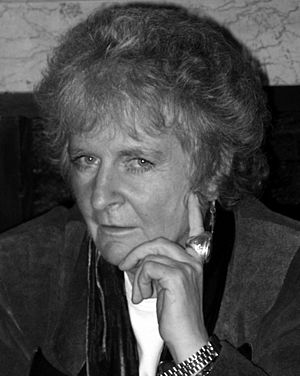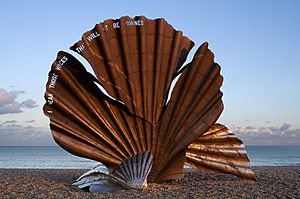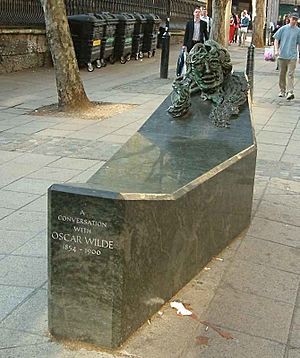Maggi Hambling facts for kids
Quick facts for kids
Maggi Hambling
|
|
|---|---|

Hambling in 2006
|
|
| Born | 23 October 1945 Sudbury, England
|
| Nationality | British |
| Education |
|
| Known for | painting, sculpture |
| Awards | |
Margaret J. Hambling (born 23 October 1945) is a famous British artist. She is mainly known for her paintings. However, some of her most recognized public artworks are sculptures. These include A Conversation with Oscar Wilde and A Sculpture for Mary Wollstonecraft in London. Another famous work is the 4-meter-high steel sculpture Scallop on Aldeburgh beach. All three of these sculptures have caused some discussion and debate.
Contents
Early Life and Art Education
Maggi Hambling was born in Sudbury, Suffolk, England. Her father, Harry, was a bank cashier and also enjoyed painting. Her mother, Marjorie, taught ballroom dancing. Maggi had two older siblings, Ann and Roger.
Maggi was very close to her mother. She also learned a lot from her father. He discovered his talent for painting after he retired. He even had his paintings shown at the Royal Academy of Arts.
Maggi started studying art at a young age. Her first art teacher was Yvonne Drewry at the Amberfield School. She then attended the East Anglian School of Painting and Drawing from 1960. Later, she studied at Ipswich School of Art (1962–64). She continued her studies at Camberwell College of Arts (1964–67). Finally, she went to the Slade School of Art at University College London (1967–69). She finished her art education in 1969.
Artistic Career
Maggi Hambling is well-known for her detailed paintings of land and sea. She created a famous series of paintings about the North Sea. Many of her portraits are displayed in the National Portrait Gallery in London.
In 1980, Maggi Hambling became the first artist to work at the National Gallery. This special role is called an "artist in residence." After this, she painted a series of portraits of the comedian Max Wall. She has also taught art at the Wimbledon School of Art.
Women are often featured in her portrait series. The National Portrait Gallery asked Hambling to paint Professor Dorothy Hodgkin in 1985. This portrait shows Hodgkin at a desk with four hands. Each hand is doing a different task. Maggi Hambling's artworks are held in many public collections. These include the British Museum and the Tate Collection. Her art can also be found in the National Gallery and the Victoria and Albert Museum.
Hambling is known for painting people after they have passed away. She painted portraits of her parents and Henrietta Moraes in their coffins. She said it helped her to continue painting them after their death. She also created a series of works about George Melly as he approached the end of his life. Maggi Hambling believes that "Making a work of art is making a work of love."
In 2013, she had an exhibition at Snape during the Aldeburgh Festival. She also had a solo exhibition at the Hermitage Museum in St. Petersburg, Russia. Maggi Hambling supports Paintings in Hospitals. This charity provides art for health and social care places.
Public Sculptures
Maggi Hambling has created several large sculptures for public spaces. These works are often discussed and sometimes cause debate.
Oscar Wilde Memorial
In 1998, Hambling created an outdoor sculpture in Charing Cross, central London. It is a memorial to the famous writer Oscar Wilde. This was the first public monument to him outside of his home country, Ireland.
The sculpture shows Wilde rising from a polished green granite coffin. He is holding a cigarette. The coffin is designed to be a public bench. This is why Hambling named it A Conversation with Oscar Wilde. Visitors can sit next to the sculpture of the writer. The artwork includes a quote from Wilde's play Lady Windermere's Fan. It says: "We are all in the gutter but some of us are looking at the stars."
Some people did not like the sculpture at first. However, many supporters said the public loved it. The cigarette on the sculpture was often removed by people. It is no longer replaced.
Benjamin Britten Memorial (Scallop)

The Scallop sculpture was created in 2003. It celebrates the composer Benjamin Britten. The sculpture stands on the beach outside Aldeburgh, Suffolk. This area is close to where Britten lived and near Hambling's village.
The sculpture is 4 meters (about 13 feet) high. It is made of cast stainless steel. It looks like two broken halves of a scallop shell. The sculpture has a quote from Britten's opera Peter Grimes etched into it. The quote says: "I hear those voices that will not be drowned."
Hambling describes Scallop as a conversation with the sea. She said that at the center of the sculpture, you can hear the waves and wind. Visitors can sit there and think about the sea's power. Some people did not like the sculpture. They felt it spoiled the natural beach. A local petition against it gathered many signatures. The sculpture has also been damaged a few times.
For this artwork, Hambling received the 2006 Marsh Award for Excellence in Public Sculpture.
Mary Wollstonecraft Memorial
In May 2018, Maggi Hambling was chosen to create a statue for Mary Wollstonecraft. Wollstonecraft was an important writer and thinker. She is known as the "foremother of feminism." A group called Mary on the Green had been working since 2011 to create a memorial for her. They chose Hambling for the sculpture.
Hambling's design shows a figure emerging from organic material. This figure is meant to represent an "everywoman." It is inspired by Wollstonecraft's idea of being "the first of a new genus." A famous quote from Wollstonecraft is on the base of the sculpture. It says: "I do not wish women to have power over men but over themselves."
The sculpture is called A Sculpture for Mary Wollstonecraft. It was revealed in Newington Green, north London, on November 10, 2020. It is across from the Newington Green Unitarian Church. Mary Wollstonecraft used to worship there. Newington Green is known as the birthplace of feminism. This is because Wollstonecraft lived and worked there. She moved her school for girls to Newington Green in 1784.
The sculpture caused some discussion. Some people felt it was not a good representation of Wollstonecraft. Hambling defended her design. She said that "clothes would have restricted her." She also said that "Statues in historic costume look like they belong to history." She felt it was important for the figure to feel "now." The sculpture's design was meant to be different from traditional statues of male heroes.
Awards and Recognition
Maggi Hambling has received several important awards for her art.
- In 1995, she won the Jerwood Painting Prize.
- In the same year, she was given an OBE. This award recognized her contributions to painting.
- In 2005, she received the Marsh Award for Excellence in Public Sculpture for her Scallop artwork.
- In the 2010 New Year Honours, she was awarded a CBE. This stands for Commander of the Most Excellent Order of the British Empire. It was given for her services to art.
- In 2022, she received the Suffolk Medal. She had actually designed this medal herself.
Personal Life
Maggi Hambling lives in a cottage near Saxmundham in Suffolk, England.
Political Views
In August 2014, Maggi Hambling was one of 200 public figures. They signed a letter to The Guardian newspaper. The letter was against Scottish independence. This was before the 2014 vote on that issue. In 2024, she donated money to the Labour Party.


